Abstract
To assess the effect of protein binding by human serum on the synergistic interaction of penicillins with gentamicin, time-kill curves were determined for four penicillins alone and in combination with gentamicin against 10 blood isolates of enterococci. Killing curves demonstrated synergism with penicillin G plus gentamicin against all 10 strains in either broth or 50% human serum. In broth the combinations of nafcillin plus gentamicin and oxacillin plus gentamicin were synergistic against 10 of 10 strains and 4 of 10 strains, respectively. However, in serum, nafcillin plus gentamicin was synergistically bactericidal against only two strains and oxacillin plus gentamicin against none. Methicillin plus gentamicin was synergistic against none of the enterococci in either medium. Thus, the semisynthetic, penicillinase-resistant penicillins are unlikely to be effective in the therapy of patients with enterococcal endocarditis.
Full text
PDF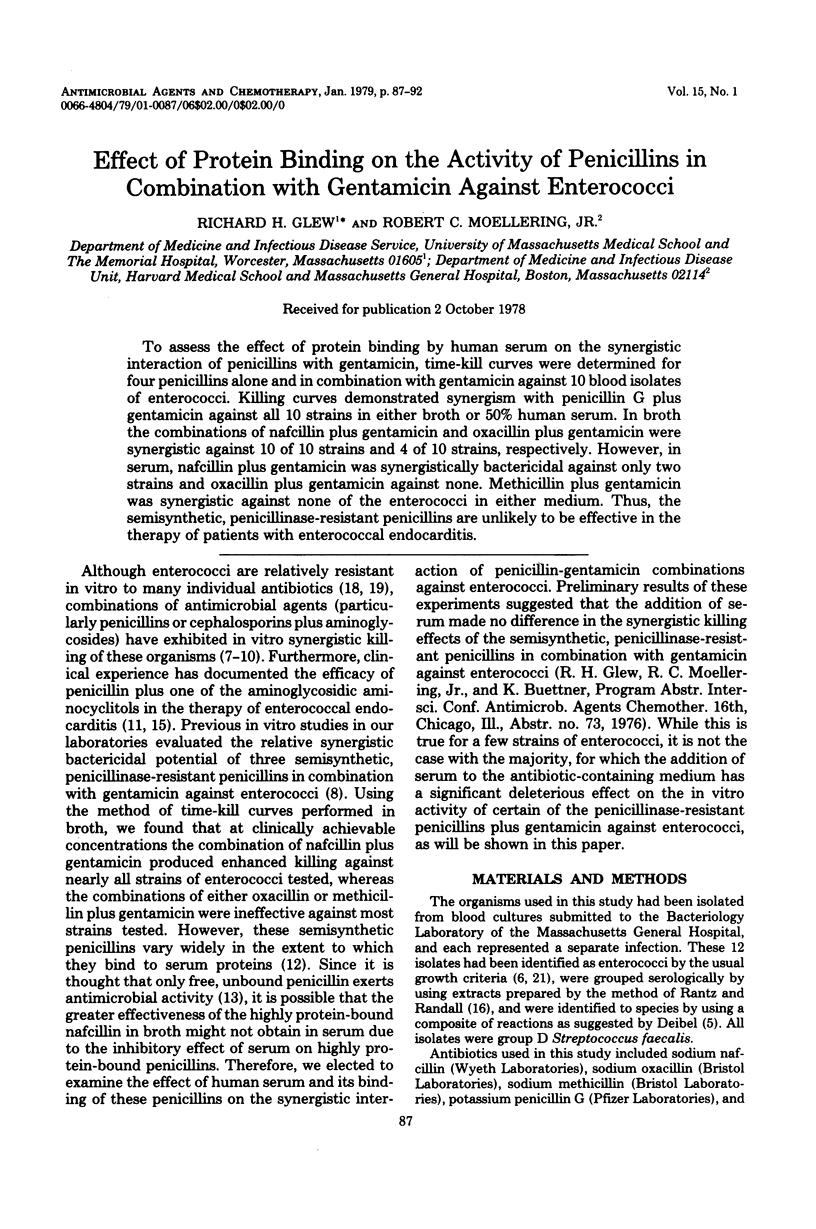
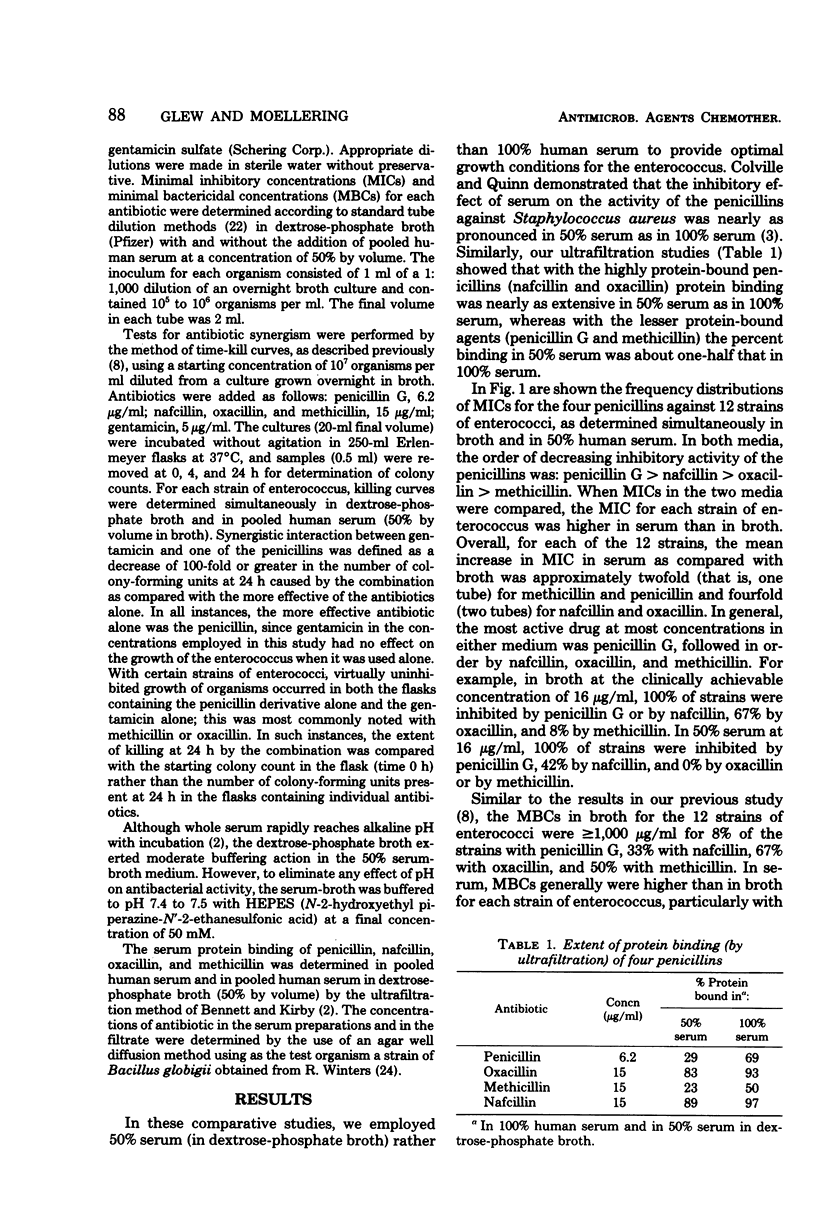
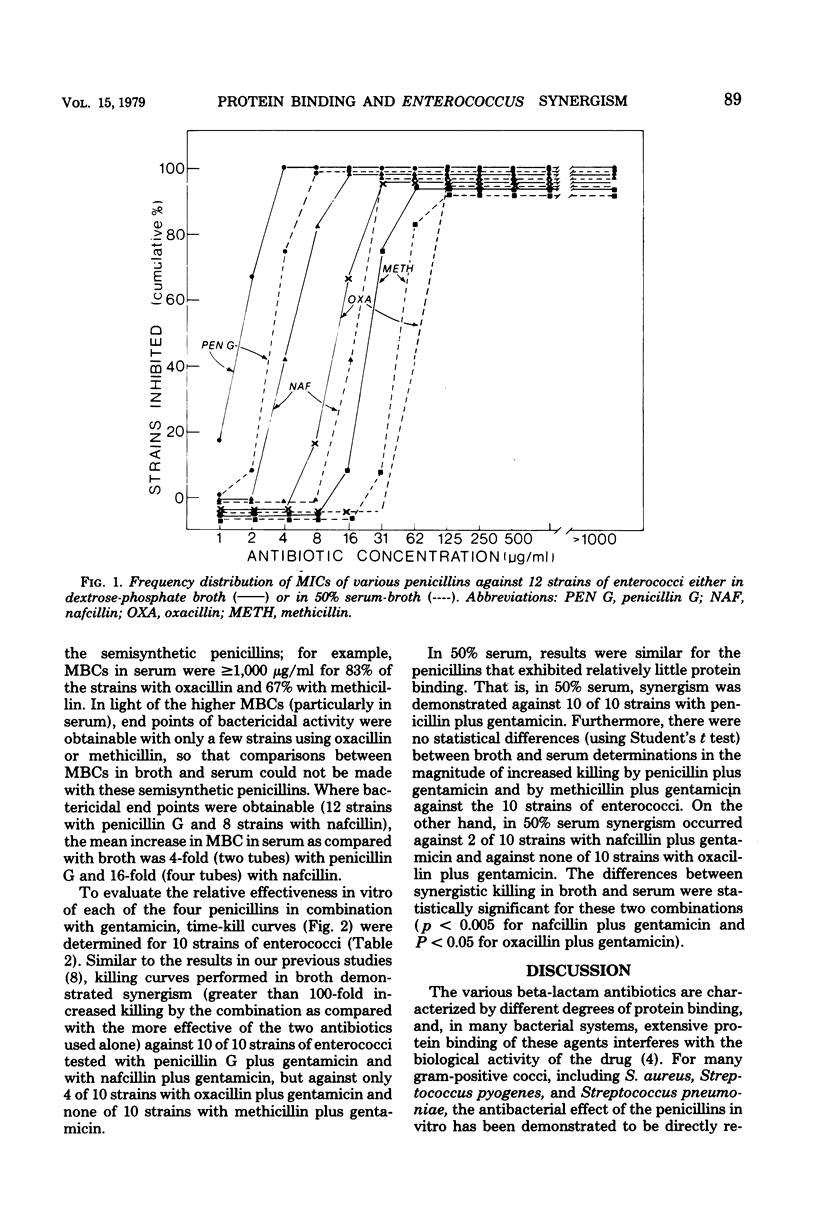
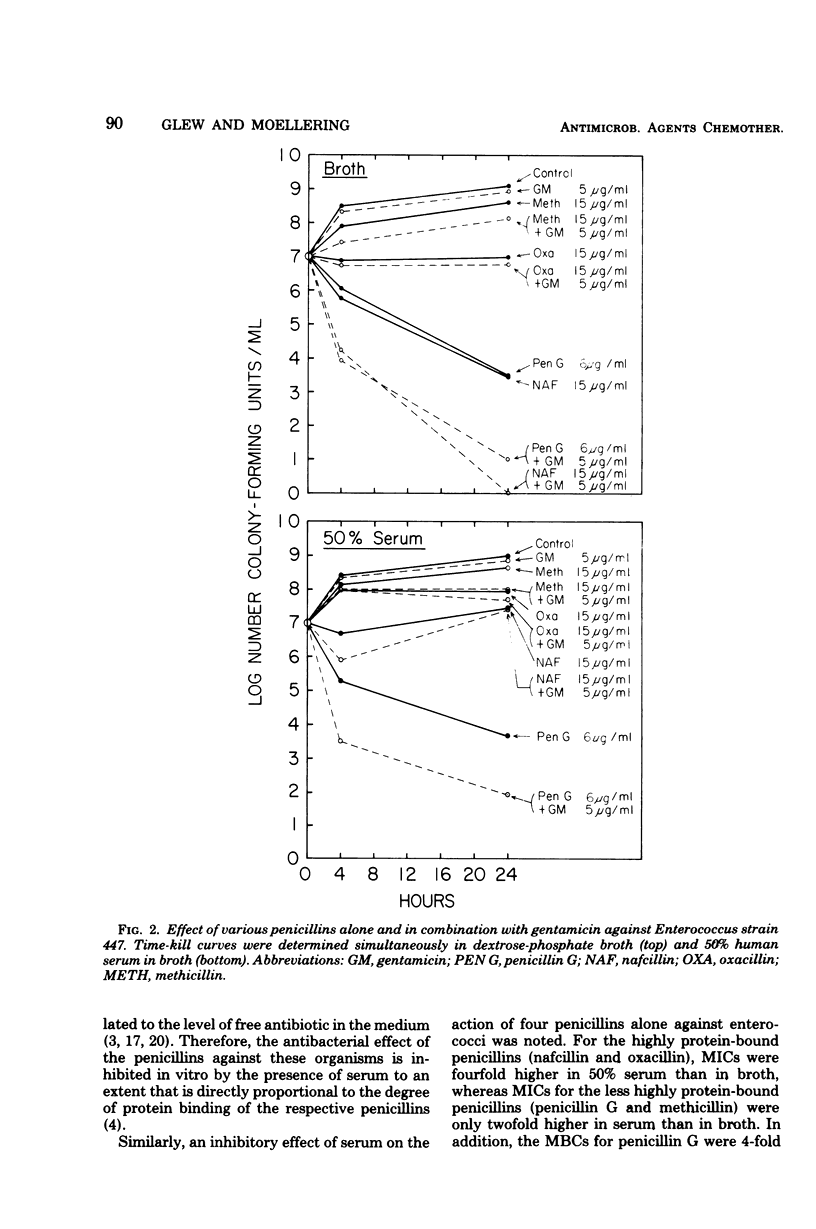
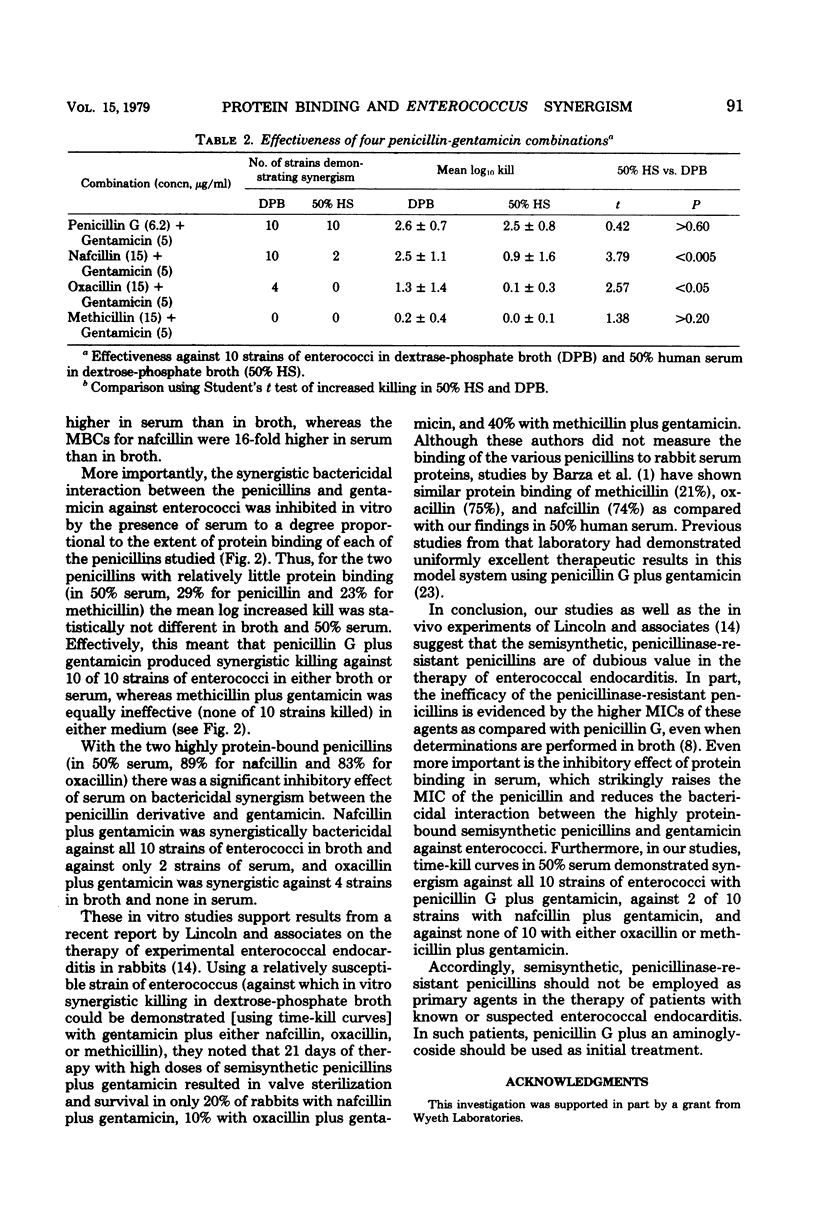
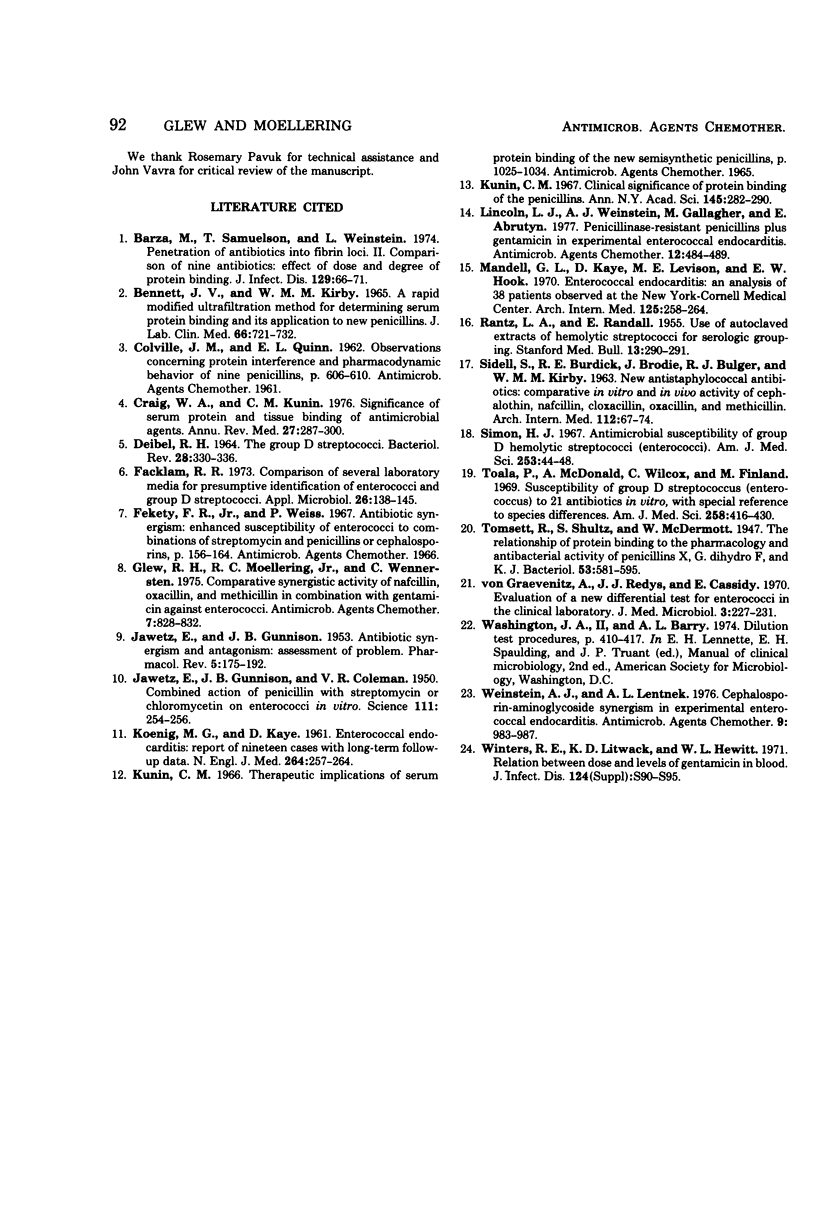
Selected References
These references are in PubMed. This may not be the complete list of references from this article.
- Barza M., Samuelson T., Weinstein L. Penetration of antibiotics into fibrin loci in vivo. II. Comparison of nine antibiotics: effect of dose and degree of protein binding. J Infect Dis. 1974 Jan;129(1):66–72. doi: 10.1093/infdis/129.1.66. [DOI] [PubMed] [Google Scholar]
- Bennett J. V., Kirby W. M. A rapid, modified ultrafiltration method for determining serum protein binding and its application to new penicillins. J Lab Clin Med. 1965 Nov;66(5):721–732. [PubMed] [Google Scholar]
- Craig W. A., Kunin C. M. Significance of serum protein and tissue binding of antimicrobial agents. Annu Rev Med. 1976;27:287–300. doi: 10.1146/annurev.me.27.020176.001443. [DOI] [PubMed] [Google Scholar]
- DEIBEL R. H. THE GROUP D STREPTOCOCCI. Bacteriol Rev. 1964 Sep;28:330–366. doi: 10.1128/br.28.3.330-366.1964. [DOI] [PMC free article] [PubMed] [Google Scholar]
- Facklam R. R. Comparison of several laboratory media for presumptive identification of enterococci and group D streptococci. Appl Microbiol. 1973 Aug;26(2):138–145. doi: 10.1128/am.26.2.138-145.1973. [DOI] [PMC free article] [PubMed] [Google Scholar]
- GREEN J., MISTILIS S., SCHIFF L. Acute alcoholic hepatitis. A clinical study of fifty cases. Arch Intern Med. 1963 Jul;112:67–78. doi: 10.1001/archinte.1963.03860010113013. [DOI] [PubMed] [Google Scholar]
- Glew R. H., Millering R. S., Jr, Wennersten C. Comparative synergistic activity of nafcillin, oxacillin, and methicillin in combination with gentamicin against. Antimicrob Agents Chemother. 1975 Jun;7(6):828–832. doi: 10.1128/aac.7.6.828. [DOI] [PMC free article] [PubMed] [Google Scholar]
- JAWETZ E., GUNNISON J. B. Antibiotic synergism and antagonism; an assessment of the problem. Pharmacol Rev. 1953 Jun;5(2):175–192. [PubMed] [Google Scholar]
- Jawetz E., Gunnison J. B., Coleman V. R. The Combined Action of Penicillin with Streptomycin or Chloromycetin on Enterococci in Vitro. Science. 1950 Mar 10;111(2880):254–256. doi: 10.1126/science.111.2880.254. [DOI] [PubMed] [Google Scholar]
- KOENIG M. G., KAYE D. Enterococcal endocarditis. Report of nineteen cases with long-term follow-up data. N Engl J Med. 1961 Feb 9;264:257–264. doi: 10.1056/NEJM196102092640601. [DOI] [PubMed] [Google Scholar]
- Kunin C. M. Clinical significance of protein binding of the penicillins. Ann N Y Acad Sci. 1967 Sep 27;145(2):282–290. doi: 10.1111/j.1749-6632.1967.tb50225.x. [DOI] [PubMed] [Google Scholar]
- Lincoln L. J., Weinstein A. J., Gallagher M., Abrutyn E. Penicillinase-resistant penicillins plus gentamicin in experimental enterococcal endocarditis. Antimicrob Agents Chemother. 1977 Oct;12(4):484–489. doi: 10.1128/aac.12.4.484. [DOI] [PMC free article] [PubMed] [Google Scholar]
- Mandell G. L., Kaye D., Levison M. E., Hook E. W. Enterococcal endocarditis. An analysis of 38 patients observed at the New York Hospital-Cornell Medical Center. Arch Intern Med. 1970 Feb;125(2):258–264. doi: 10.1001/archinte.125.2.258. [DOI] [PubMed] [Google Scholar]
- RANTZ L. A., RANDALL E. Use of autoclaved extracts of hemolytic streptococci for serological grouping. Stanford Med Bull. 1955 May;13(2):290–291. [PubMed] [Google Scholar]
- Toala P., McDonald A., Wilcox C., Finland M. Susceptibility of group D streptococcus (enterococcus) to 21 antibiotics in vitro, with special reference to species differences. Am J Med Sci. 1969 Dec;258(6):416–430. doi: 10.1097/00000441-196912000-00006. [DOI] [PubMed] [Google Scholar]
- Tompsett R., Shultz S., McDermott W. The Relation of Protein Binding to the Pharmacology and Antibacterial Activity of Penicillins X, G, Dihydro F, and K. J Bacteriol. 1947 May;53(5):581–595. doi: 10.1128/jb.53.5.581-595.1947. [DOI] [PMC free article] [PubMed] [Google Scholar]
- Weinstein A. J., Lentnek A. L. Cephalosporin-aminoglycoside synergism in experimental enterococcal endocarditis. Antimicrob Agents Chemother. 1976 Jun;9(6):983–987. doi: 10.1128/aac.9.6.983. [DOI] [PMC free article] [PubMed] [Google Scholar]
- Winters R. E., Litwack K. D., Hewitt W. L. Relation between dose and levels of gentamicin in blood. J Infect Dis. 1971 Dec;124 (Suppl):S90–S95. doi: 10.1093/infdis/124.supplement_1.s90. [DOI] [PubMed] [Google Scholar]
- von Graevenitz A., Redys J. J., Cassidy E. Evaluation of a new differential test for enterococci in the clinical laboratory. J Med Microbiol. 1970 May;3(2):227–231. doi: 10.1099/00222615-3-2-227. [DOI] [PubMed] [Google Scholar]


